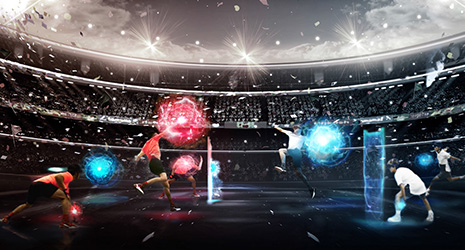Home > Highlighting JAPAN > Highlighting Japan October 2019 > THE SPORTING LIFE
Highlighting JAPAN


“Superhuman Sports” for All
“Superhuman Sports” are gaining popularity around the world as sports that anyone can enjoy, regardless of differences in strength or whether or not they have a disability, by using technology.
The Superhuman Sports Society aims to develop new sports that everyone can enjoy by incorporating the latest technologies such as robotics and computer technology to acquire strength that goes beyond the limits of natural human ability. The society plans to hold an exhibition in Tokyo in 2020, the year of the Olympics and Paralympics. Masahiko Inami, joint representative of the society, says, “Only a select handful of players can participate in the Olympic and Paralympic Games. Of course, that's great, but it would be good to also have sports that everyone can participate in equally, by using technology to reduce differences arising from physique or disabled or able-bodied status. That’s how we came up with the idea of ‘Superhuman Sports.’”
The Superhuman Sports Society was formed in 2015. With a membership made up of researchers, engineers, media artists, game creators, and athletes, the society works to develop and scout new events. So far, the society has officially certified twenty-two events. Some of the most popular are Bubble Jumper, a combat sport where players wrapped in transparent bubble protectors crash into their opponents, and HADO, where two teams of three players wearing AR (augmented reality) goggles fire virtual energy balls at each other while trying to dodge their opponent like a dodgeball game.
Inami conducts research on human augmentation engineering, which enhances human actions and senses aided by technology, at the Research Center for Advanced Science and Technology, the University of Tokyo. Inami’s research leapt to worldwide prominence around fifteen years ago when he created an actual optical camouflage cloak that makes the person wearing it look invisible, which featured in the science fiction film Ghost in the Shell. Commenting on the fusion of technology and pop culture such as manga and anime, Inami says, “Human augmentation engineering should help resolve many challenges in society, including those relating to medical care. When technology ceases to be concerned solely with usefulness and an element of ‘fun’ is added, it will evolve and become more popular.”
Superhuman Sports are also seeking to innovate by trialing the application of technology within the framework of sports. To that end, the society holds an annual Superhuman Sports Hackathon, bringing together researchers and creators from various backgrounds and private companies under one roof to create new games in accordance with the three guiding principles of Superhuman Sports: “All participants can enjoy sports”; “Sports continue to evolve with technology”; and “All spectators can enjoy sports.”
The popularity of Superhuman Sports is growing in Asia, especially in Hong Kong and Taiwan. Last year, the Superhuman Sports Design Challenge was held at the Delft University of Technology in the Netherlands, presenting events from all over Europe and offering an opportunity for participants to try them out.
The Superhuman Sports Society does not seek to create major sports with large numbers of people taking part. Rather, its aim is to develop a diverse range of sports. “If there are many different sports, you may find one that suits you. I myself won the Hover Crosse ball game tournament that involves trying to score goals while standing on an electric-powered balance board. For someone like me who was never any good at sports, it was a really impressive achievement,” says Inami.
Everyone can participate, and everyone has the opportunity to be a winner. Superhuman Sports show that technology offers hope for a diverse and inclusive society.
© 2009 Cabinet Office, Government of Japan







